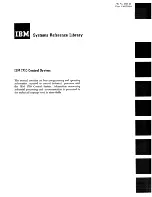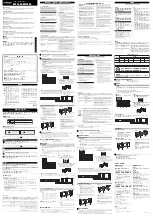
Manual No. 4801- 2997 Rev 1-15
Secondary Sensing System
17 of 42
6.
General Operation
6.1
Alarm Inputs
The
S
3
has seven inputs that can be used to sound an alarm; Three from temperature sensors, three
auxiliaries, and one for power out. The temperature sensors can be enabled or disabled. If a sensor is
enabled it will be used to generate an alarm. If a sensor is disabled, it will not generate an alarm, even if
the
S
3
determines that its readings are out of limits. The Auxiliary and Power Out inputs are always
enabled. The seven alarm inputs are:
6.1.1 Temperature Sensors #1 ,#2 and #3
The
S
3
comes from the factory with three temperature sensors. The
S
3
will trigger an alarm if the
temperature goes above the high limit setpoint or below the low limit setpoint of the sensors. The
S
3
will
wait 30 seconds after a sensor indicates it is out of range before triggering an alarm.
6.1.2 Auxiliary Inputs #1, #2, and Control System
The
S
3
is equipped with three auxiliary inputs. These inputs are connected in a closed loop circuit. On the
circuit board located on the door of the alarm enclosure there is a terminal block for connecting the
Auxiliary Inputs (See
Section 11.8
for a connection diagram). Each of the connections has an IN and OUT
terminal. If, at any time, the connection between the IN and OUT positions is broken (opened), the alarm
will sound. There are many devices on the market that could be used with these inputs. For instance,
water pressure switches, light meters, and thermostats could all be used. The
S
3
will wait 30 seconds after
an auxiliary input is broken before triggering an alarm.
6.1.3 Power Out
The Power Out alarm indicates that there has been no AC electricity present on the alarm power feed for at
least 30 seconds.
AC Power Fuse:
If it is found that there is power present at the electrical outlet and the Power Alarm is ON at the
S
3
, the 3
Amp slow-blow fuse located on the
S
3
circuit board (Fuse F1) should be checked for a blown fuse. To
replace a fuse, disconnect AC power, disconnect the positive (+) battery terminal from the battery,
carefully replace the blown fuse with the correctly sized replacement fuse, reconnect the positive (+)
battery terminal to the battery, reapply AC power, and verify the power alarm has cleared. The
S
3
will wait
60 seconds after a Power Out indication before triggering an alarm.
Refer to the
S
3
Circuit Board Layout
in Section 11.2 and Fuse Replacement in Section 8.4.
Terminal Connections to the Battery:
If AC power is out or disconnected from the
S
3
AND none of the
S
3
Displays or LED’s are ON, verify that
the Battery Positive (+) and Battery Negative (-) quick-connect terminals are securely attached to the
battery. Refer to the
S
3
Wiring in Section 11.2.
If the AC power is OFF for an extended period of time with the alarms ON, the Back-Up Battery will
eventually be drained of all power. Refer to
Section 8
for additional troubleshooting information.
6.2
Alarm Outputs
The
S
3
has two alarm outputs. These can be used individually or simultaneously. The alarm outputs are:
6.2.1 Siren
The siren hookup to the
S
3
will deliver a 12 volt DC signal with a current up to 1.0 amps. Many operators
want to mount the siren a long distance from the controller. Sometimes, this is desirable in order to locate
the siren closer to their dwelling, sometimes to get it away from their animals. The use of a small gauge
wire to connect the Alert Alarm to the siren could cause a great deal of voltage drop. This voltage drop, in
turn, can cause the siren to become inoperative. If the operator wants to mount the siren more than 50 feet
from the controller, a relay with a 12VDC rated coil should be used to switch current to the siren. When a
relay is added, the operator must provide a separate battery and charger for the siren circuit.
















































